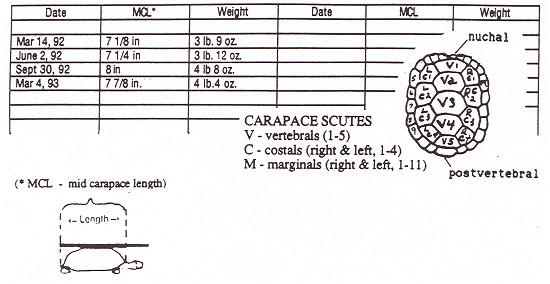Start a journal. Use a notebook that is at least 6″ x 91/2″. Use for this one purpose. There should be a minimum of two sections. One for General Observations and one for Periodic Measurements.
GENERAL OBSERVATIONS
If you have more than one tortoise, make a section for each tortoise. At the top of the first page for that tortoise, record its common name and sex if known, scientific name, and your name for the tortoise, such as, “Tank” male desert tortoise, Gopherus agassizii. On the first page say where the tortoise came from and when. Identify the journal with your name and address.
Suggested Kinds of Observations to Record
- Behavior during first few days after you receive the Tortoise.
- Fall Behavior, brumation (hibernation) and Spring Emergence. Dates such as when tortoise starts to slow down, changes in feeding. Date starts to stay in burrow for several days at a time. Date no longer emerges. First emergence in spring, what it does on surface, date emergence becomes a daily event. Date starts to eat. What is eaten/refused.
- Eating Habits. Choice of growing food through the season. Date accepts major change in diet.
- Reproductive Behavior. Juvenile (male) first starts to head-bob at and court a female. Head-bobbing by adult male as a sign of courting (not followed by attempts to flip).
- Response of female. Duration of parts of the event. Egg laying, duration of parts of the event, number of eggs if possible. You can watch without disturbing. Nest site. If a damp place, date moved by you. How and where? First sighting of each hatchling, number hatched.
- Other Behavior. Date, time, tortoise(s) involved, duration of event. Behavior of hatchling. Describe any separate area for them. Head bobbing preceding aggressive/defensive behavior. Individuals involved and their sexes. Describe behavior of each tortoise. Behavior of any “loser” after an encounter. Drinking, when and where, duration. Use of burrows and other places for cover. Sharing of burrows.
Other Observations or Occurrences.
- Change in appearance. New growth visible on the shell, size of chin glands. Response to visits to school or other demonstrations. Duration of event.
- Disease or Injury. IF TORTOISE WAS ADOPTED FROM TORTOISE GROUP, NOTIFY THEM. Injury site and cause, if known. Signs of disease. Eating or not. If and when taken to the vet for treatment. Describe treatment and results. Stool specimen taken to vet for analysis for parasites. Results.
- Questions and Unusual Observations. Make a separate section at back of journal. Write in date and short reference to a question or special observation recorded under General Observations. Such as, “April 1, 1996: Tank eating an unknown weed.” Collect weed for identification. Fill in the name when you find out.”June 14, 1996: Trudy head-bobs and shoves Tank!” Isn’t this unusual for a female? ” July 2, 1996: Trudy digs partial nest and then walks away from hole.” Is this normal?
PERIODIC MEASUREMENTS
See Tortoise Group Information Sheet #3 “Measuring Tortoise Size. Start a separate sheet for each tortoise regardless of how you organize the General Observations. Weigh and measure at least twice a year–just before brumation (hibernation) and upon emergence from brumation. The shell is slightly flexible and may expand and contract with the ambient temperature. If the tortoise is growing very slowly, a given measurement may be slightly smaller than the last measurement. The following is an example of how you might head journal pages and record measurements.
PERIODIC MEASUREMENTS:Desert Tortoise (Gopherus agassizii), “Tank”, subadult male
Implanted microchip ID No. 001-759-212, External ID, “4071” on carapace scute V5 and “Tortoise Group Las Vegas, NV” in on RC4 (or your phone number on _____)

